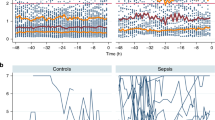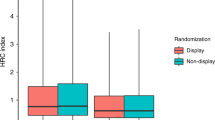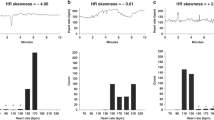Abstract
Estimating the risk of in-hospital mortality in the newborn intensive care unit can provide important information for health-care providers, and illness severity scores have been devised to provide mortality risk estimates. Calculation of illness severity scores is time-consuming, and the information used to predict mortality is collected only for the first 12 to 24 h of life. A noninvasive continuous measure that uses information collected throughout the hospitalization and that requires no data entry could be less costly and more informative. We have previously shown that the abnormal heart rate characteristics (HRC) of reduced variability and transient decelerations accompany neonatal illness such as late-onset sepsis. We hypothesized that more frequent and severe abnormal HRC are associated with an increased risk of death. We tested this hypothesis in two ways. Using data on infants older than 7 d of age, we first determined the association of the HRC index with death in the next week. Second, we devised a cumulative HRC score and determined its association with in-hospital death. There were 37 deaths in the 685 patients. The major findings were 1) the HRC index showed highly significant association with death in the succeeding 7 d (receiver-operating characteristic area > 0.7, p < 0.001), and 2) the cumulative HRC was highly significantly associated with neonatal in-hospital mortality (receiver-operating characteristic area > 0.80, p < 0.001). In both analyses, HRC added information to birth weight, gestational age, and postnatal age (p< 0.01). The HRC index provides independent information about the risk of neonatal death in the upcoming 7 d, and the cumulative HRC is an estimate of the risk of in-hospital neonatal mortality.
Similar content being viewed by others
Log in or create a free account to read this content
Gain free access to this article, as well as selected content from this journal and more on nature.com
or
Abbreviations
- NICU:
-
newborn intensive care unit
- HRC:
-
heart rate characteristics
- ROC:
-
receiver-operating characteristic
- HR:
-
heart rate
- SIRS:
-
systemic inflammatory response syndrome
- UVa:
-
University of Virginia
- WFU:
-
Wake Forest University
- BW:
-
birth weight
- GA:
-
gestational age
- cHRC:
-
cumulative heart rate characteristics
- SNAP:
-
Score for Acute Neonatal Physiology
- RR interval:
-
interval between heartbeats
References
Richardson DK, Gray JE, McCormick MC, Workman K, Goldmann DA 1993 Score for Neonatal Acute Physiology: a physiologic severity index for neonatal intensive care. Pediatrics 91: 617–623.
Richardson DK, Phibbs CS, Gray JE, McCormick MC, Workman-Daniels K, Goldmann DA 1993 Birth weight and illness severity: independent predictors of neonatal mortality. Pediatrics 91: 969–975.
Pollack MM, Koch MA, Bartel DA, Rapoport I, Dhanireddy R, El Mohandes AA, Harkavy K, Subramanian KN 2000 A comparison of neonatal mortality risk prediction models in very low birth weight infants. Pediatrics 105: 1051–1057.
International Neonatal Network, 1993 The CRIB (clinical risk index for babies) score: a tool for assessing initial neonatal risk and comparing performance of neonatal intensive care units. Lancet 342: 193–198.
Horbar JD, Onstad L, Wright E 1993 Predicting mortality risk for infants weighing 501 to 1500 grams at birth: a National Institutes of Health Neonatal Research Network report. Crit Care Med 21: 12–18.
Meadow W, Frain L, Ren Y, Lee G, Soneji S, Lantos J 2002 Serial assessment of mortality in the neonatal intensive care unit by algorithm and intuition: certainty, uncertainty, and informed consent. Pediatrics 109: 878–886.
Griffin MP, Moorman JR 2001 Toward the early diagnosis of neonatal sepsis and sepsis-like illness using novel heart rate analysis. Pediatrics 107: 97–104.
Griffin MP, OShea TM, Bissonette EA, Harrell FE Jr, Lake DE, Moorman JR 2003 Abnormal heart rate characteristics preceding neonatal sepsis and sepsis-like illness. Pediatr Res 53: 920–926.
Bone RC 1997 Important new findings in sepsis. JAMA 278: 249
Bone RC, Grodzin CJ, Balk RA 1997 Sepsis: a new hypothesis for pathogenesis of the disease process. Chest 112: 235–243.
Bone RC 1996 Immunologic dissonance: a continuing evolution in our understanding of the systemic inflammatory response syndrome (SIRS) and the multiple organ dysfunction syndrome (MODS). Ann Intern Med 125: 680–687.
Bone RC 1996 The sepsis syndrome: definition and general approach to management. Clin Chest Med 17: 175–181.
Bone RC 1996 Toward a theory regarding the pathogenesis of the systemic inflammatory response syndrome: what we do and do not know about cytokine regulation. Crit Care Med 24: 163–172.
Ozdemir A, Brown MA, Morgan WJ 1997 Markers and mediators of inflammation in neonatal lung disease. Pediatr Pulmonol 23: 292–306.
Kotecha S 1996 Cytokines in chronic lung disease of prematurity. Eur J Pediatr 155( suppl 2): S14–S17.
Blanco A, Solis G, Arranz E, Coto GD, Ramos A, Telleria J 1996 Serum levels of CD14 in neonatal sepsis by Gram-positive and Gram-negative bacteria. Acta Paediatr 85: 728–732.
Atici A, Satar M, Alparslan N 1996 Serum interleukin-1 beta in neonatal sepsis. Acta Paediatr 85: 371–374.
Ng PC, Cheng SH, Chui KM, Fok TF, Wong MY, Wong W, Wong RP, Cheung KL 1997 Diagnosis of late onset neonatal sepsis with cytokines, adhesion molecule, and C-reactive protein in preterm very low birthweight infants. Arch Dis Child Fetal Neonatal Ed 77:F221–F227.
de Bont ES, de LH Okken A, Baarsma R, Kimpen JL 1995 Increased plasma concentrations of interleukin-1 receptor antagonist in neonatal sepsis. Pediatr Res 37: 626–629.
Spear ML, Stefano JL, Fawcett P, Proujansky R 1995 Soluble interleukin-2 receptor as a predictor of neonatal sepsis. J Pediatr 126: 982–985.
de Bont ES, Martens A, van RJ, Samson G, Fetter WP, Okken A, de LH, Kimpen JL 1994 Diagnostic value of plasma levels of tumor necrosis factor alpha (TNF alpha) and interleukin-6 (IL-6) in newborns with sepsis. Acta Paediatr 83: 696–699
de Bont ES, Martens A, van RJ, Samson G, Fetter WP, Okken A, de LH 1993 Tumor necrosis factor-alpha, interleukin-1 beta, and interleukin-6 plasma levels in neonatal sepsis. Pediatr Res 33: 380–383
Dulkerian SJ, Kilpatrick L, Costarino ATJ, McCawley L, Fein J, Corcoran L, Zirin S, Harris MC 1995 Cytokine elevations in infants with bacterial and aseptic meningitis. J Pediatr 126: 872–876.
Shalak LF, Laptook AR, Jafri HS, Ramilo O, Perlman JM 2002 Clinical chorioamnionitis, elevated cytokines, and brain injury in term infants. Pediatr 110: 673–680.
Patrick LA, Smith GN 2002 Proinflammatory cytokines: a link between chorioamnionitis and fetal brain injury. J Obstet Gynaecol Can 24: 705–709.
Harris MC, Costarino ATJ, Sullivan JS, Dulkerian S, McCawley L, Corcoran L, Butler S, Kilpatrick L 1994 Cytokine elevations in critically ill infants with sepsis and necrotizing enterocolitis. J Pediatr 124: 105–111.
Kovatchev BP, Farhy LS, Cao H, Griffin MP, Lake DE, Moorman JR 2003 Sample asymmetry analysis of heart rate characteristics with application to neonatal sepsis and systemic inflammatory response syndrome. Pediatr Res 54: 892–898.
Richman JS, Moorman JR 2000 Physiological time series analysis using approximate entropy and sample entropy. Am J Physiol Heart Circ Physiol 278:H2039–H2049.
Chang KL, Monahan KJ, Griffin MP, Lake DE, Moorman JR 2001 Comparison and clinical application of frequency domain methods in analysis of neonatal heart rate time series. Ann Biomed Eng 29: 764–774.
Lake DE, Richman JS, Griffin MP, Moorman JR 2002 Sample entropy analysis of neonatal heart rate variability. Am J Physiol Regul Integr Comp Physiol 283:R789–R797.
Nelson JC, Rizwanuddin, Griffin MP, Moorman JR 1998 Probing the order within neonatal heart rate variability. Pediatr Res 43: 823–831.
Harrell FE, Pollock BG, Lee KL 1988 Regression models in clinical studies: determining relationships between predictors and response. J Natl Cancer Inst 80: 1198–1202.
Harrell FE, Margolis PA, Gove S, Mason KE, Mulholland EK, Lehmann D, Muhe L, Gatchalian S, Eichenwald HF 1998 Development of a clinical prediction model for an ordinal outcome: the World Health Organization Multicentre Study of Clinical Signs and Etiological Agents of Pneumonia, Sepsis and Meningitis in Young Infants. WHO/ARI Young Infant Multicentre Study Group. Stat Med 17: 909–944.
Feng Z, McLerran D, Grizzle J 1996 A comparison of statistical methods for clustered data analysis with Gaussian error. Stat Med 15: 1793–1806.
Griffin MP, Scollan DF, Moorman JR 1994 The dynamic range of neonatal heart rate variability. J Cardiovasc Electrophysiol 5: 112–124.
Garner JS, Jarvis WR, Emori TG, Horan TC, Hughes JM 1988 CDC definitions for nosocomial infections, 1988. Am J Infect Control 16: 128–140.
Stein B, Frank P, Schmitz W, Scholz H, Thoenes M 1996 Endotoxin and cytokines induce direct cardiodepressive effects in mammalian cardiomyocytes via induction of nitric oxide synthase. J Mol Cell Cardiol 28: 1631–1639.
Oddis CV, Simmons RL, Hattler BG, Finkel MS 1994 Chronotropic effects of cytokines and the nitric oxide synthase inhibitor, L-NMMA, on cardiac myocytes. Biochem Biophys Res Commun 205: 992–997.
Oddis CV, Finkel MS 1997 Cytokines and nitric oxide synthase inhibitor as mediators of adrenergic refractoriness in cardiac myocytes. Eur J Pharmacol 320: 167–174.
Hakonarson H, Herrick DJ, Serrano PG, Grunstein MM 1996 Mechanism of cytokine-induced modulation of beta-adrenoceptor responsiveness in airway smooth muscle. J Clin Invest 97: 2593–2600.
Richardson DK, Tarnow-Mordi WO, Escobar GJ 1998 Neonatal risk scoring systems. Can they predict mortality and morbidity? Clin Perinatol 25: 591–611.
Acknowledgements
The authors thank Terri Smoot, Nancy Peters, and the physicians and nurses of the UVa and WFU NICUs for integral contributions to the data acquisition.
Author information
Authors and Affiliations
Corresponding author
Additional information
Supported by NIGMS-64640; American Heart Association, Mid-Atlantic Consortium; Children's Medical Center Research Fund, University of Virginia; W.S. Paley Foundation; Virginia's Center for Innovative Technology; and Medical Decision Networks, Charlottesville, VA.
Disclosure: There is a potential for conflict of interest. Medical Predictive Science Corporation of Charlottesville, VA, has a license to market technology related to HRC monitoring of newborn infants, and supplied partial funding for this study. After completion of this study, Drs. Griffin and Moorman acquired an equity share in this company.
Rights and permissions
About this article
Cite this article
Griffin, M., O'Shea, T., Bissonette, E. et al. Abnormal Heart Rate Characteristics Are Associated with Neonatal Mortality. Pediatr Res 55, 782–788 (2004). https://doi.org/10.1203/01.PDR.0000119366.21770.9E
Received:
Accepted:
Issue date:
DOI: https://doi.org/10.1203/01.PDR.0000119366.21770.9E
This article is cited by
-
Sample entropy correlates with intraventricular hemorrhage and mortality in premature infants early in life
Pediatric Research (2024)
-
Fetal heart rate variability is a biomarker of rapid but not progressive exacerbation of inflammation in preterm fetal sheep
Scientific Reports (2022)
-
Discovery of signatures of fatal neonatal illness in vital signs using highly comparative time-series analysis
npj Digital Medicine (2022)
-
Monitoring of heart rate characteristics to detect neonatal sepsis
Pediatric Research (2022)
-
Introducing heart rate variability monitoring combined with biomarker screening into a level IV NICU: a prospective implementation study
European Journal of Pediatrics (2022)



